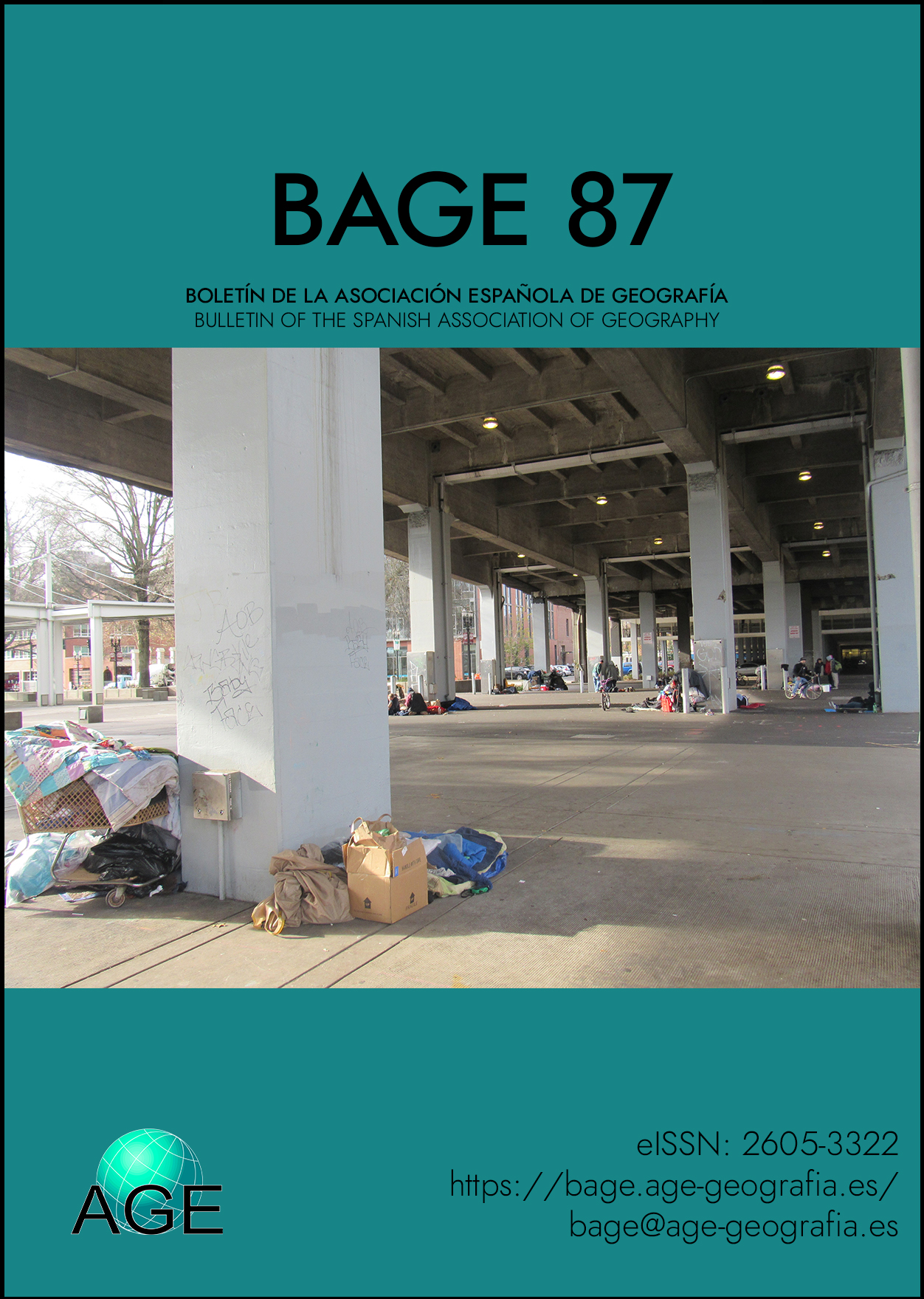Rethinking the politics of vulnerability: neighborhood empowerment in Kansas City Missouri (USA)
Main Article Content
Abstract
The paper provides evidence for the racialization of urban neighborhoods in Kansas City Missouri, USA and the ways in which voluntary associations of citizens work to resist and reduce conditions of urban vulnerability. The paper presents data from historical patterns of racially-biased real estate practices, including redlining, and demonstrates how these patterns continue to shape the politics of vulnerability in the region today. Three neighborhood profiles provide evidence of the ways in which local neighborhood associations are organized to respond to both social and spatial conditions of vulnerability. In contrast to the estimates of low community resilience in these neighborhoods, the author demonstrates that neighborhood empowerment is an important counterpoint to concentrated vulnerabilities.
Downloads
Article Details

This work is licensed under a Creative Commons Attribution-NonCommercial 4.0 International License.
References
Aguirre, B. (2007). Dialectics of vulnerability and resilience. Georgetown Journal on Poverty Law and Policy, 14(1), 39-60. Retrieved from https://heinonline.org/HOL/P?h=hein.journals/geojpovlp14&i=41
Anguelovski, I. (2014). Neighborhood as Refuge: Community Reconstruction, Place Remaking and Environmental Justice in the City. Cambridge, MA: The MIT Press.
Benner, C., & Pastor, M. (2012). Just Growth: Inclusion and Prosperity in America’s Metropolitan Regions. Oxfordshire: Routledge.
Betancur, J., & J. Smith. (2016). Claiming Neighborhood: New ways of understanding urban change. Chicago: University of Illinois Press.
Burgess, E. (1925). The Growth of the City: An introduction to the Research Project. In R. Park, E. Burgess & R. D. McKenzie (Eds.), The City (pp. 47-62). Chicago: University of Chicago Press.
Cortright, J., & D. Mahmoudi (2014). Lost in Place: Why the persistence and spread of concentrated poverty – not gentrification – is our biggest urban challenge. City Observatory. Retrieved from https://cityobservatory.org/wp-content/uploads/2014/12/LostinPlace_12.4.pdf
Drake, St. C., & Cayton, H. R. (1945). Black Metropolis: A Study of Negro Life in a Northern City. New York: Harcourt, Brace and Co.
DuBois, W.E.B. (1899). The Philadelphia Negro: A Social Study. Philadelphia: The University of Pennyslvania Press.
Fullilove, M. T. (2020). Main Street: How a City’s Heart Connects Us All. New York: New Village Press.
Gallopín G. (2006). Linkages between vulnerability, resilience and adaptive capacity. Global Environmental Change, 16, 293-303.
Garcia-Hallett, J., Like, T., Torres, T., & Irazábal, C. (2020). Latinxs in the Kansas City Metro Area: Policing and Criminalization in Ethnic Enclaves. Journal of Planning Education and Research, 40(2), 151-168. https://doi.org/10.1177/0739456X19882749
Gotham, K. F. (2002a). Race, real estate, and uneven development: The Kansas City experience, 1900-2000. Albany: State University of New York Press.
Gotham, K. F. (2002b). Beyond Invasion and Succession: School Segregation, Real Estate Blockbusting, and the Political Economy of Neighborhood Racial Transition. City & Community, 1(1), 83–111. https://doi.org/10.1111/1540-6040.00009
Gotham, K. F., & R. Campanella. (2011). Coupled vulnerability and resilience: the dynamics of cross-scale interactions in post-Katrina New Orleans. Ecology and Society, 16(3), 12. http://dx.doi.org/10.5751/ES-04292-160312
Hoyt, H. (1939). The Structure and Growth of Residential Neighborhoods in American Cities. Washington DC, US Government Printing Office.
Irazábal, C., & J. Neville (2007). Neighborhoods in the Lead: Grassroots planning for social transformation in post-Katrina New Orleans? Planning Practice & Research, 22(2), 131-153. https://doi.org/10.1080/02697450701584329
Jacobs, J. (1961). The Uses of City Neighborhoods, In The Death and Life of Great American Cities (pp. 112-140). New York: Random House.
Kansas City (Mo.), City Plan Commission (1947). The master plan for Kansas City. Kansas City. Retrieved from https://catalog.hathitrust.org/Record/000649525
Kretzmann, J., & J. L. McKnight. (1993). Building Communities from the Inside Out: A Path Toward Finding and Mobilizing a Community's Assets. Evanston, IL: Institute for Policy Research.
Massey, D. S., & Denton, N. A. (1993). American Apartheid: Segregation and the making of the underclass. Cambridge, Mass.: Harvard University Press.
Nelson, R. K., Winling, L., Marciano, R., Connolly, N., et al. (n.d.). Mapping Inequality. In American Panorama. Retrieved from https://dsl.richmond.edu/panorama/redlining
Pader, E.-J. (1994). Spatial Relations and Housing Policy: Regulations that Discriminate Against Mexican-origin Households. Journal of Planning Education and Research, 13(2), 119–135. https://doi.org/10.1177/0739456X9401300204
Perry, C. (1929). The Neighborhood Unit. In Regional Plan of New York and its Environs. New York: Regional Plan of New York and Its Environs.
Robert Woods Johnson Foundation (2015). Kansas City MO: Culture of Health Prize Winner. In Robert Woods Johnson Foundation. Retrieved from https://www.rwjf.org/en/library/articles-and-news/2015/10/coh-prize-kansascity-mo-story.html
Rollinson, P. (1998). The Everyday Geography of the Homeless in Kansas City. Geografiska Annaler. Series B, Human Geography, 80(2), 101-115.
Thomas, J. M. (1998). Racial Inequality and Empowerment: Necessary Theoretical Constructs for Understanding U.S. Planning History. In L. Sandercock (Ed.), Making the Invisible Visible: A Multicultural Planning History (pp. 198-208). Berkeley: University of California Press.
United States Census Bureau (2018). American Community Survey (2014-2018, 5-year estimates). Retrieved from https://www.census.gov/programs-surveys/acs/technical-documentation/table-and-geography-changes/2018/5-year.html
United States Census Bureau (2020). Community Resilience Estimates. Retrieved from https://www.census.gov/data/experimental-data-products/community-resilience-estimates.html
Vey, J. S. (2006). Organizing for Success: A Call to Action for the Kansas City Region. In The Brookings Institution. Metropolitan Policy Program.Research Brief.
Weichselgartner, J., & Kelman, I. (2015). Geographies of resilience: Challenges and opportunities of a descriptive concept. Progress in Human Geography, 39(3), 249-267. https://doi.org/10.1177/0309132513518834
Woods, C. A. (1998). Development arrested: The blues and plantation power in the Mississippi Delta. London: Verso.
Young, I. M. (1990). Justice and the politics of difference. Princeton, N.J: Princeton University Press.

